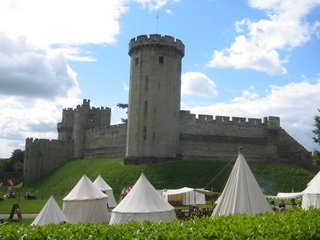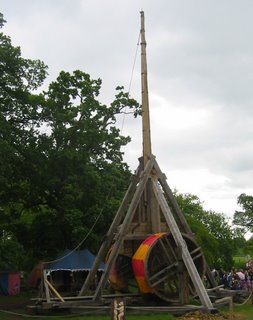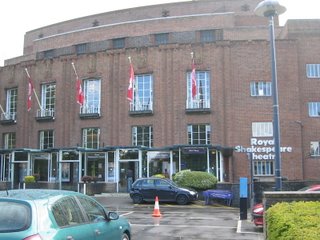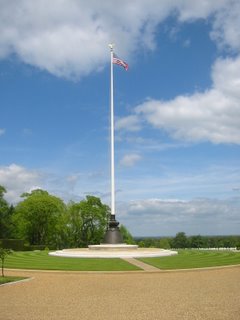Warwick Castle & Stratford-Upon-Avon
We planned another very busy trip, this time for Sara, Keith, and Tom. On Monday, we left early and drove to Warwick Castle. The first castle on this site was built in about 1064 at the command of William the Conqueror. Over the next 400 years it was rebuilt and expanded to what it is today.

As soon as you enter the castle grounds, you are surrounded by actors playing their medieval parts. One of them announced that people should beware of Sara because she was a colonialist! This was our first view of the castle.

The walkway leads you up over the original moat and through the main gate.

The Mound, pictured here, was also built on orders from William the Conqueror to provide a defense for the castle. The wall you see does run around all four sides of the castle.

The Mill and Engine house lie along the River Avon. The earliest mill at the castle dates to the 12th century. This one dates from the 14th century.

This picture shows Guy's Tower, situated near the main castle gate. This twelve-sided tower was built in the 14th century, standing 39 meters high.

Here you can see a part of the main castle containing many of the state rooms: the Chapel, Dining Room, Great Hall, Armoury, several Drawing Rooms, all of which have period displays.

This picture was taken from the top of Guy's Tower. It shows part of the main castle building.

From Guy's Tower, the views were wonderful. Here is Caesar's Tower behind the main castle gate.

Another view shows the tents set up on the grounds. Represented there were cooks, garment makers, blacksmiths, wheelwrights, tanners, coopers, ... all the standard medieval trades.

The highlight of the visit was the launching of a 15kg rock from a great trebuchet!

Here is the trebuchet loaded and ready to be launched. It launched its payload almost a quarter mile!

Here is a close-up of the trebuchet. It requires at least 5 men to work the contraption.

Well, no medieval castle is worth the name unless they stage a joust, so we stayed for that as well, although there was very little jousting and lots of 'playing.'

These two knights were the 'good guys.'

Can you tell that this Black Knight and the Red Knight in the first picture are the 'bad guys?'

After Warwick Castle, we drove on to Shakespeare's hometown, Stratford-Upon-Avon. What a beautiful town, even in the rain!

The owner of this boat must be a Lord of the Rings fan!

This is the town library. 'Shakespeare' was out front pantomiming (and scaring unwitting tourists).

This is Shakespeare's birthplace. It is a beautiful medieval building with a lovely garden in back.

This just shows you how ominous the skies looked while we were in Stratford. It made for a stunning picture.

This beautiful building is called the Shakespeare Hostelry.

This is Nash's House. Nash was the husband of Shakespeare's granddaughter.

This is a view of the side of Nash's House as seen from the garden.

We believe the part of the house in back is 'New Place,' which Shakespeare bought in 1597 with his London earnings. He later died there, in 1616.

This is the Falcon Hotel. Wouldn't you just love to stay in a hotel like this?

Walking down the passage by Nash's House brought us to this famous building -- the Swan Theatre. It makes sense that it is so close to Shakespeare's dwellings.

The Royal Shakespeare Theatre occupies the same building as the Swan, but at the opposite end. This is where we saw a great production of Romeo and Juliet on Monday night.

There were dozens of swans on the River Avon.

This is a beautiful view of the one bridge in town that crosses the River Avon.

Here is the Royal Shakespeare Theatre as seen from across the River Avon. The Swan Theatre is under the roof in the background.

The park at the marina sported this statue of Shakespeare surrounded by statues of some of his most famous characters, among them . . .

Lady Macbeth . . .

...and Hamlet.

We spent the night at this rustic B&B called Holly-Tree Cottage. The main house dates from the 17th century.

Holly-Tree Cottage is surrounded by beautiful countryside. It's too bad we weren't around long enough to enjoy the serenity.
On Tuesday: Stoneleigh Abbey, and Coventry...
































